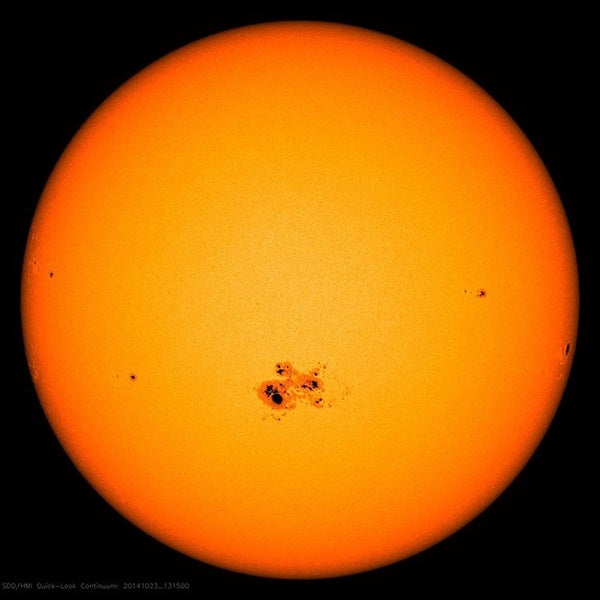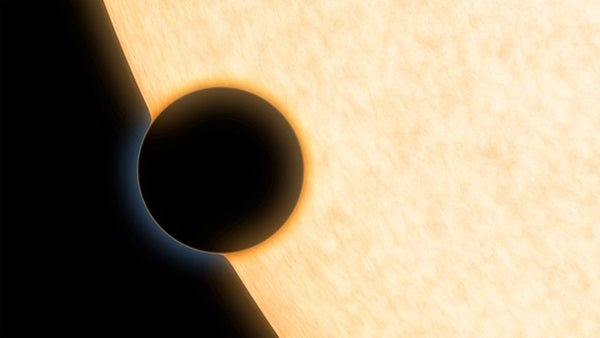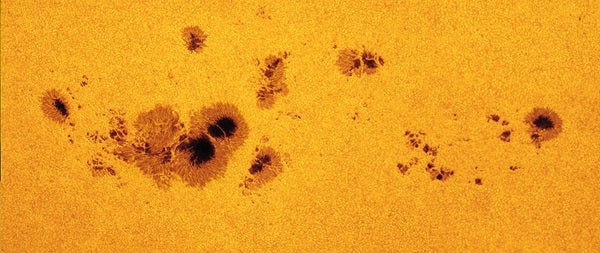Small dark regions on the Sun have helped solar scientists learn more about our closest star for centuries. But while picking out sunspots is reasonably easy on our Sun, identifying them on Sun-like stars lying light-years away can be a challenge. Now astronomers have used an orbiting planet to probe starspots on its star, revealing once again that our own Sun isn’t anything special — which comes as a relief to scientists who have long modeled behavior on other stars after our own.
“The distribution of the spots on the Sun is an outward expression of what’s going on within the Sun, making visible the magnetic fields that are anchored deep below the surface,” Brett Morris, a fifth-year Ph.D. candidate at the University of Washington, said by email. Morris worked with a team of astronomers that used observations made by NASA’s Kepler spacecraft to measure spots on the distant star HAT-P-11. By measuring the location and activity of the starspots, they found that the star acted much like the Sun.
“Astronomers have been trying to make sense of the sunspot distribution since records of sunspots began, so we often make assumptions that other stars will behave like the Sun, because it’s the only star we know up close,” Morris said.
Kepler hunts for planets by measuring dips in the brightness of the stars they orbit. As planets pass between the telescope and their sun, the light drops ever so slightly. At the same time, the planets can help reveal sunspots because more light shines when the planet covers a bright part of the star than when it covers the dark starspot regions.
“The apparent dips in brightness which famously indicate the planet’s presence can also be used to measure the presence of brightness variations on the stellar surface,” Morris said.
This isn’t the first time astronomers have measured spots on faraway stars. Other methods can study large-scale magnetic activity or resolve the surface of a few large stars themselves. But according to Morris, smaller, cooler, and older stars are all more difficult to observe.
“So HAT-P-11, a middle-aged star with 80 percent the mass of the Sun, would ordinarily be a difficult target for activity studies if it weren’t for its planet,” he said.
By using a planet, researchers were also able to target smaller spots than they would have been otherwise able to see.
It also helps that its planet circles the poles of its star, rather than the equator. Kepler was able to view the Neptune-sized world as it crossed several different latitudes on the star, revealing activity across the surface rather than in a single band of rotation and highlighting where starspots were most plentiful. Over four years of observations, the researchers found the starspots clustered much like those on our Sun. Typical spots were about 25,000 miles (40,000 kilometers) across, roughly three times the size of Earth. The largest spot stretched about 105,600 miles (170,000 km) across, a bit larger than Jupiter, which is comparable to the Sun’s largest spots.
Because the gas giant orbits its star far closer than Earth orbits the Sun, observing spots would be a bit different on the surface-free exoplanet.
“If you were hovering in the blisteringly-hot day-side atmosphere of the planet HAT-P-11b and you looked up at the star, it would stretch nearly 8 degrees in diameter across the sky – 15 times larger than the Full Moon observed from Earth,” Morris said. “The largest starspot we observed would be twice the size of the Full Moon as observed from Earth. The naked eye could resolve substructure in the spots, like the bright outer region called the penumbra, and the darker central region called the umbra.”
“Just be sure to bring your eclipse glasses, and a great heat-resistant suit,” he added.
After years of using the Sun as a “standard” star, astronomers can rest at ease knowing they were right.
“In a sense, it’s a relief that Sun-sized stars have Sun-like activity,” Morris said. “We can now be a bit more confident when we assume Sun-stars behave like the Sun.”
The research was published in The Astrophysical Journal.












